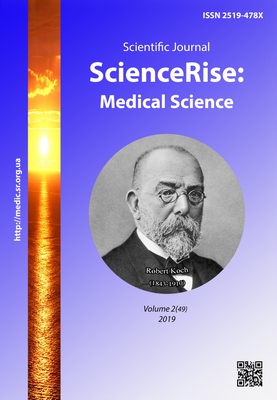Analysis of rational food for children with chronic gastropathology
DOI:
https://doi.org/10.15587/2519-4798.2019.162340Keywords:
gastrointestinal tract diseases, nutrition, diet, questioning, schoolchildren, research, gastropathologyAbstract
Diseases of the digestive system in children occupy a leading place in the structure of the somatic pathology of childhood. Eating disorders, eating substandard food, overeating and inadequate chewing, eating spicy foods, eating a dry meal, as well as monotonous malnutrition the most important causes of acute and chronic diseases of the stomach and intestines. Therefore, the strategy of therapeutic measures in diseases of the digestive system is aimed at correcting metabolic disorders and adequately providing energy and constructive metabolism.
The aim of our study was to analyze the actual nutrition of children with chronic pathology of the upper gastrointestinal tract.
Materials and methods. 102 patients with chronic pathology of the upper gastrointestinal tract, aged from 3 to 17 years, were surveyed. A questionnaire was created for the survey, which included questions regarding ideas about proper nutrition, diet, the patient's usual menu and his dietary preferences. Patients were divided into 4 age groups.
Results. According to our research, patients suffering from diseases of the upper GI tract, in general, try to adhere to the diet. Differences were observed in compliance with the diet, the type of heat treatment of food and the preferred dishes in children in different age groups. Younger children and preschoolers are more likely to follow the doctor’s recommendations on nutrition, while children in primary and high school often violate their diet or use improperly processed foods. The main violations in the diet occur due to the use of "fast food", sweets and bakery products in large quantities.
Conclusion. Given that most of the violations in the diet are in the primary and high school age groups, it was concluded that more attention should be paid to patients of this age and to explain to them about the need to comply with the recommendations of doctors on diet. Introduce measures to organize proper nutrition and control for this age group. The results of this study will serve as the basis for the development of motivating programs for patients with gastrointestinal diseases for following them recommendations on nutrition
References
- Lazareva, L. A., Gordeeva, E. V. (2017). Analysis of digestive apparatus disease incidence among children and adolescents. Mezhdunarodniy nauchno-issledovatel'skiy zhurnal, 01 (55), 133–135. doi: http://doi.org/10.23670/IRJ.2017.55.104
- Tulieva, M. S., Rainskaya, A. S. (2015). Osobennosti pitaniya lyudey s zabolevaniyami zheludochno-kishechnogo trakta. Molodoy ucheniy, 6.3, 55–57. Available at: https://moluch.ru/archive/86/16493/
- Gigun, T. V. (2006). Lechebnoe pitanie pri zabolevaniyah ZhKT. Moscow, 254.
- Pogozheva, A. V. (2012). Standarty dietoterapii pri zabolevaniya organov ZhKT. Prakticheskaya dietologiya, 3 (3). Available at: https://praktik-dietolog.ru/article/57.html
- Mironova, I. V., Galieva, Z. A., Rebezov, M. B., Motavina, L. I., Smol'nikova, F. H. (2015). Osnovy lechebno-profilakticheskogo pitaniya. Semey, 112.
- Burceva, T. I., Rebezov, M. B., Asenova, B. K., Stadnikova, S. V. (2015). Razvitie tekhnologiy funkcional'nyh i specializirovannyh produktov pitaniya zhivotnogo proiskhozhdeniya. Almaty: MAP, 215.
- Kvyatkovskiy, I. E., Sagitova, G. R. (2010). Sovremennye tekhnologii ozdorovleniya detey v shkol'nyh obrazovatel'nyh uchrezhdeniyah. Astrahan', 82.
- Nuradenov, H. P., Sagitova, G. R. (2014). Lechebno-profilakticheskie meropriyatiya sredi starsheklassnikov, stradayushchih zabolevaniyami organov pishchevareniya. Sovremennye problemy nauki i obrazovaniya, 5. Available at: https://www.science-education.ru/ru/article/view?id=14663
- Andersen, R., Biltoft-Jensen, A., Christensen, T., Andersen, E. W., Ege, M., Thorsen, A. V. et. al. (2015). What do Danish children eat, and does the diet meet the recommendations? Baseline data from the OPUS School Meal Study. Journal of Nutritional Science, 4. doi: https://doi.org/10.1017/jns.2015.17
- Evans, C. E. L., Greenwood, D. C., Thomas, J. D., Cade, J. E. (2010). A cross-sectional survey of children's packed lunches in the UK: food- and nutrient-based results. Journal of Epidemiology & Community Health, 64 (11), 977–983. doi: https://doi.org/10.1136/jech.2008.085977
Downloads
Published
How to Cite
Issue
Section
License
Copyright (c) 2019 Natalya Kramarenko, Ekaterina Skriabina, Natalia Sapa

This work is licensed under a Creative Commons Attribution 4.0 International License.
Our journal abides by the Creative Commons CC BY copyright rights and permissions for open access journals.
Authors, who are published in this journal, agree to the following conditions:
1. The authors reserve the right to authorship of the work and pass the first publication right of this work to the journal under the terms of a Creative Commons CC BY, which allows others to freely distribute the published research with the obligatory reference to the authors of the original work and the first publication of the work in this journal.
2. The authors have the right to conclude separate supplement agreements that relate to non-exclusive work distribution in the form in which it has been published by the journal (for example, to upload the work to the online storage of the journal or publish it as part of a monograph), provided that the reference to the first publication of the work in this journal is included.









